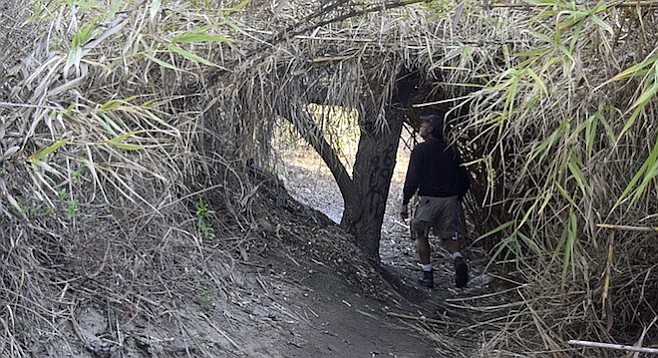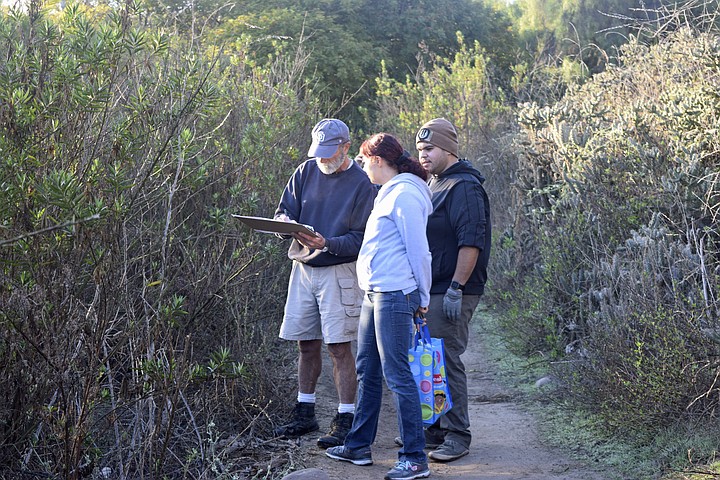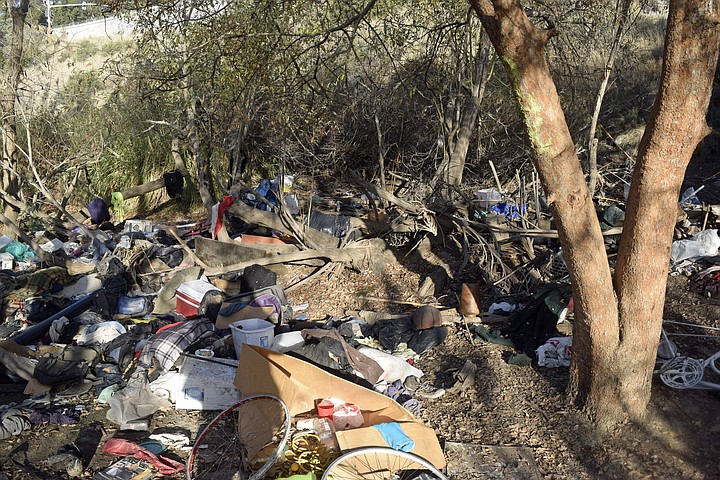 Facebook
Facebook
 X
X
 Instagram
Instagram
 TikTok
TikTok
 Youtube
Youtube

During the early morning hours of January 26th, more than 1500 volunteers fanned out across the county to conduct the annual We All Count census of homeless San Diegans.

In Santee and Mission Valley, the San Diego River Park Foundation manages the count in the riverbed areas. As a regular volunteer with the foundation, I was invited to help this year. I met my fellow volunteers at sunrise at the Starbucks at Fairmount Avenue and Camino del Rio North, one of the four rendezvous locations in Mission Valley. Tiffany Swiderski, a clean-river manager with the foundation, separated us into three teams and distributed maps of the area each team would be responsible for. She also had some advice for us.
Swiderski has established a relationship with quite a few of the people who make their home along the river. She didn’t anticipate any problems but explained that some campsites were very close to the trails we’d be using. Our presence could make people feel vulnerable or defensive.

“If you’re challenged, just yell out ‘San Diego River Park Foundation, we’re just passing through,’ and you’ll be fine,” she suggested. Paul, my team leader, said he had room for all of us for the short ride to our assigned area. He led us to a gleaming red-and-white Volkswagen bus and we piled in.
As we drove, we introduced ourselves. Masha, Cipto, and Juan all work for various departments in the county government. Masha explained that the county is very big on encouraging employees to volunteer for the count. Paul is a retired librarian and member of the foundation’s river rescue team, volunteering regularly to remove trash from the San Diego River.

Once Paul had parked in a corner of the lot at the Fairmount Avenue Home Depot, we made our way to an opening in the perimeter fence. One by one, we stepped from a concrete drainage pipe onto the soft damp earth of the riverbed. Almost immediately I noticed a bright blue tarp suspended from a tree limb into an improvised tent. Our task for the census was to count any such structures we found, as well as vehicles that appeared to be inhabited and individuals who seemed to be living in the riverbed.
Paul made the appropriate notes on the map, and the team fanned out and headed upstream. Working our way toward San Diego Mission Road, we found some trash, but nothing relevant to our count. Once we’d crossed the street and worked our way to the west bank of the river, the vegetation got thicker. The trail led us into the brush and under pepper trees, where clearings opened under the canopy, connected by tunnels like a rabbits’ warren. Here we found a commercial camping tent tucked in the bushes and marked our map again.
Our area to cover ended at Friars Road, and it was here, under the bridge, that we discovered a man folding bedding. After turning back and heading toward our starting point, we encountered another man heading out of the riverbed on a bicycle. A tent we had missed on our first pass brought the census totals for our team to two individuals, three makeshift structures, and no inhabited vehicles.
Once we made it back to Paul’s van a little more than two hours later, we returned to Starbucks and reported our findings.
Shannon Quigley-Raymond, river ecosystem manager for the foundation, oversaw the participation in this year’s We All Count. She said that 11 teams totaling 31 volunteers conducted the census in Mission Valley, finding a total of 50 tents or other structures, 7 inhabited vehicles, and 41 individuals experiencing homelessness.
“There was a 30 percent reduction between this year and last year,” noted Quigley-Raymond. She said a city plan to clean up the San Diego River announced by mayor Kevin Faulconer last month might be behind the lower numbers.
The data collected by the foundation volunteers were submitted to the San Diego Regional Task Force on the Homeless, which is responsible for conducting the census. Countywide results from the count will be released once they have been compiled. The census is required yearly by the federal government for local jurisdictions to receive funding for homeless services.


During the early morning hours of January 26th, more than 1500 volunteers fanned out across the county to conduct the annual We All Count census of homeless San Diegans.

In Santee and Mission Valley, the San Diego River Park Foundation manages the count in the riverbed areas. As a regular volunteer with the foundation, I was invited to help this year. I met my fellow volunteers at sunrise at the Starbucks at Fairmount Avenue and Camino del Rio North, one of the four rendezvous locations in Mission Valley. Tiffany Swiderski, a clean-river manager with the foundation, separated us into three teams and distributed maps of the area each team would be responsible for. She also had some advice for us.
Swiderski has established a relationship with quite a few of the people who make their home along the river. She didn’t anticipate any problems but explained that some campsites were very close to the trails we’d be using. Our presence could make people feel vulnerable or defensive.

“If you’re challenged, just yell out ‘San Diego River Park Foundation, we’re just passing through,’ and you’ll be fine,” she suggested. Paul, my team leader, said he had room for all of us for the short ride to our assigned area. He led us to a gleaming red-and-white Volkswagen bus and we piled in.
As we drove, we introduced ourselves. Masha, Cipto, and Juan all work for various departments in the county government. Masha explained that the county is very big on encouraging employees to volunteer for the count. Paul is a retired librarian and member of the foundation’s river rescue team, volunteering regularly to remove trash from the San Diego River.

Once Paul had parked in a corner of the lot at the Fairmount Avenue Home Depot, we made our way to an opening in the perimeter fence. One by one, we stepped from a concrete drainage pipe onto the soft damp earth of the riverbed. Almost immediately I noticed a bright blue tarp suspended from a tree limb into an improvised tent. Our task for the census was to count any such structures we found, as well as vehicles that appeared to be inhabited and individuals who seemed to be living in the riverbed.
Paul made the appropriate notes on the map, and the team fanned out and headed upstream. Working our way toward San Diego Mission Road, we found some trash, but nothing relevant to our count. Once we’d crossed the street and worked our way to the west bank of the river, the vegetation got thicker. The trail led us into the brush and under pepper trees, where clearings opened under the canopy, connected by tunnels like a rabbits’ warren. Here we found a commercial camping tent tucked in the bushes and marked our map again.
Our area to cover ended at Friars Road, and it was here, under the bridge, that we discovered a man folding bedding. After turning back and heading toward our starting point, we encountered another man heading out of the riverbed on a bicycle. A tent we had missed on our first pass brought the census totals for our team to two individuals, three makeshift structures, and no inhabited vehicles.
Once we made it back to Paul’s van a little more than two hours later, we returned to Starbucks and reported our findings.
Shannon Quigley-Raymond, river ecosystem manager for the foundation, oversaw the participation in this year’s We All Count. She said that 11 teams totaling 31 volunteers conducted the census in Mission Valley, finding a total of 50 tents or other structures, 7 inhabited vehicles, and 41 individuals experiencing homelessness.
“There was a 30 percent reduction between this year and last year,” noted Quigley-Raymond. She said a city plan to clean up the San Diego River announced by mayor Kevin Faulconer last month might be behind the lower numbers.
The data collected by the foundation volunteers were submitted to the San Diego Regional Task Force on the Homeless, which is responsible for conducting the census. Countywide results from the count will be released once they have been compiled. The census is required yearly by the federal government for local jurisdictions to receive funding for homeless services.
Comments